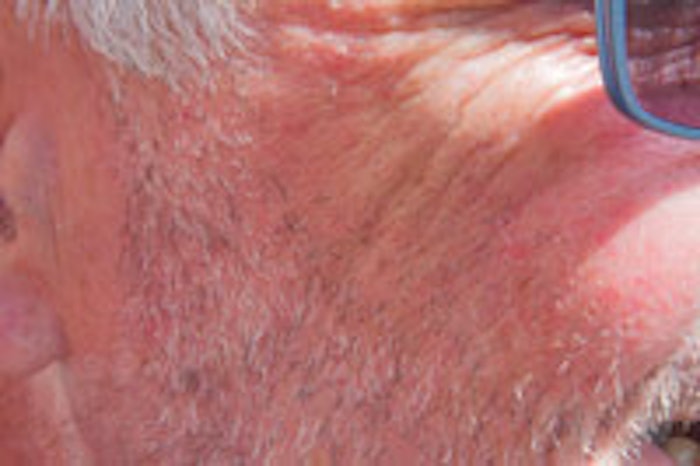
Skin side effects associated with chemotherapy are generally not life-threatening, but care and treatment can be life-enhancing, helping to significantly improve quality of life. Not only is skin fragile because of cancer treatments, but also the majority of clients receiving targeted therapies experience an acnelike rash. In most cases, the rash appears on the face, scalp, chest, back and around the ears. Although labeled as acne, this is not the same as teenage acne. Why this acne occurs is not well understood. The signaling pathways for the formation of the skin layers are thought to be disrupted. There are not increased glandular secretions.
Some physicians may try to prevent the acnelike rash or treat it with antibiotics and/or steroid creams. Some may refer to a dermatologist. These rashes gradually disappear when treatment ends without any long-term consequences. Although not considered life-threatening, these skin changes are difficult and have caused some people to stop treatments.
Initial assessment and analysis. It is tempting to diagnose a client’s needs by virtue of experience. Of course experience helps, but first, a reminder about getting back to the basics. You should be using an intake form. The responses to the following questions will generate invaluable information.
- What medical treatments has the client received?
- What medical treatments is the client currently receiving?
- How long has the client been in treatment?
- What side effects are being experienced by the client?
- Is the client having any pain?
You don’t need a full medical history, but this simple assessment will help you choose which ingredients should be introduced into the treatment plan using a holistic approach. It was important to assess how much Steve had already gone through before selecting the right treatment for his acne.
Preparation and approach. Based on the information learned, it is important to prepare the treatment room with gentle touches, including linens, scents and music that are peaceful. Aromatherapy—such as sweet orange or grapefruit to decrease nausea and improve mood—is often used. (See Approaching Clients With Cancer.)
Treatment. For Steve’s skin care service, the two priorities were relieving dehydration and treating the rash. (See Steve's Story.) When working with clients with cancer, Morgan-Lousky urges: “Try thinking differently. Remember the skin is a reflection that mirrors inner health.” Being the largest organ, it suffers damage during treatment. Cell renewal, adequate circulation, proper nutrition, sleep, hydration and water intake must all be balanced for healthy skin.
The skin has an almost endless absorption capability. An organic product line with vitamins and antioxidants to supplement the skin’s nutrition capitalizes on this capability. The enzymes and exfoliants used should be mild. Massage should be used to stimulate blood flow and remove toxins. Straight antioxidants, such as teas, should be incorporated in revitalizing the skin.
Because glycolic peels would be too harsh for this type of client, lactic acid can help obtain results that would minimize inflammation that causes folliculitis and clogged pores.
Steve’s treatment plan consisted of:
- Lactic acid treatment;
- Application of cucumber and tea tree oil followed by sweet almond milk mixed with yogurt;
- High-frequency treatment; and
- Finishing serums and moisturizers to support skin renewal.
Evaluation and ongoing care
Steve’s skin looked and felt refreshed after his time at Ahava. Dehydration is a significant problem for those being treated for cancer both during and after treatment. Skin treatments must include home-care recommendations to gently replenish lost fluids.
Upon his departure, Steve learned about the importance of sun protection, not using over-the-counter acne products on his rash, the importance of consuming 6–8 glasses of fluid daily and moisturizing with an organic moisturizer.
GENERAL REFERENCES
www.cancer.org
www.cancer.gov
ME Lacouture, Dr. Lacouture’s Skin Care Guide for People Living with Cancer, Harborside Press, Cold Spring Harbor, NY (2012)
(Websites accessed Oct 1, 2013)
Editor’s note: Don’t miss Katie Morgan-Lousky’s class with Kris Campbell of Tecniche about “The Spa Client With Cancer–Care and Concerns” during the Advanced Education Conference Program at Face & Body® Northern California in San Jose, CA, on Saturday, August 23! Register today at www.FaceandBody.com/california!
Patricia Ringos Beach is a nurse, speaker and author with advanced certification in oncology and palliative care. In Toledo, OH, she works as a patient navigator and clinical nurse specialist.
Katie Morgan-Lousky is the owner of Ahava Spa and Wellness Center in Toledo. Offering full day spa services, she also founded Cherished Friends of Ahava as a ministry where cancer patients receive spa services with sensitivity to their vulnerability and special needs.
The authors can be contacted at [email protected].










